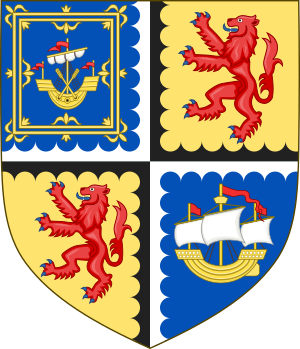George Sinclair, 6th Earl of Caithness facts for kids
Quick facts for kids
George Sinclair
|
|
|---|---|
| Earl of Caithness | |

Earl of Caithness Coat of Arms
|
|
| Predecessor | George Sinclair, 5th Earl of Caithness |
| Successor | John Campbell |
| Died | 1676 |
| Noble family | Clan Sinclair |
| Father | John Sinclair, Master of Berriedale |
| Mother | Jean Mackenzie |
George Sinclair (died 1676) was an important Scottish nobleman. He was the 6th Earl of Caithness and the leader, or chief, of the Clan Sinclair. This was a powerful Scottish clan from the Scottish Highlands.
Contents
Early Life of George Sinclair
George Sinclair, the 6th Earl of Caithness, was born into a noble family. His father was John Sinclair, Master of Berriedale. His mother was Jean, who was the daughter of Colin Mackenzie, 1st Earl of Seaforth.
George's grandfather was William Sinclair, Lord Berriedale. William was the son of George Sinclair, 5th Earl of Caithness. This made the 5th Earl George's great-grandfather. George Sinclair became the Earl of Caithness on March 21, 1644. He took over the title from his great-grandfather.
Becoming the Earl of Caithness
Role During the Civil War
After the king returned to power in Scotland, a time known as the Stuart Restoration, George Sinclair became a strong supporter of the king. He was known as a royalist. He worked to stop a group called the Covenanters, who wanted to change the church in Scotland.
George was also a member of the Privy Council of Scotland. This was a group of advisors to the king. He was also the Lord Lieutenant for the area of Caithness. This meant he was the king's main representative there.
One of George's relatives, John Sinclair of Dunbeath Castle, joined the royalist army. He fought with James Graham, 1st Marquess of Montrose. They were together at the Battle of Carbisdale in 1650. George Sinclair was also present when Oliver Cromwell was declared the leader of the three nations (England, Scotland, and Ireland).
Death and the Caithness Earldom Dispute
George Sinclair, 6th Earl of Caithness, married Mary Campbell. She was the daughter of Archibald Campbell, 1st Marquess of Argyll. However, they did not have any children.
He passed away at Thurso Castle in 1676. At the time of his death, he was also an elder in the local church in Thurso. People remembered him as a religious man. The church leaders prayed for him when he was very sick.
The Earldom of Caithness had many debts. Because of this, George had given his lands and title to his main creditor. This person was John Campbell of Glenorchy. After George's death, Campbell was made the Earl of Caithness by a special royal order.
However, this was challenged by George Sinclair of Keiss. He was a relative of the 5th Earl of Caithness. On July 13, 1680, Campbell of Glenorchy brought 800 men to remove Sinclair of Keiss. Sinclair of Keiss was waiting with 500 men near Wick.
The Sinclairs attacked Campbell's men. They were defeated in a fight known as the Battle of Altimarlach. A legend says that so many Sinclairs were defeated that the Campbells could cross the river without getting their feet wet.
In 1681, the Privy Council of Scotland decided in favor of Sinclair of Keiss. He became the 7th Earl of Caithness. John Campbell of Glenorchy was then given a different title, becoming the Earl of Breadalbane and Holland.
See also

